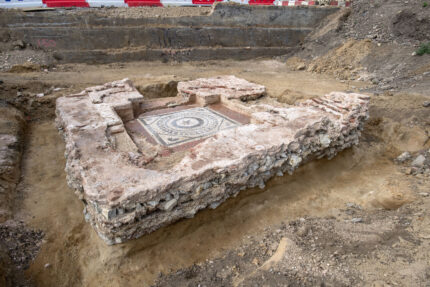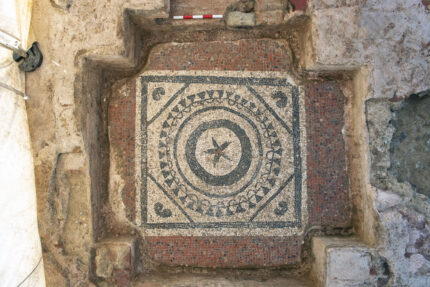 The remains of a Roman mausoleum that is the most intact ever discovered in Britain have been unearthed in London. A team from Museum of London Archaeology (MOLA) made the discovery near London Bridge in Southwark, at the site of a new multi-use development where the largest Roman mosaic found in London for over 50 years was discovered in February 2022.
The remains of a Roman mausoleum that is the most intact ever discovered in Britain have been unearthed in London. A team from Museum of London Archaeology (MOLA) made the discovery near London Bridge in Southwark, at the site of a new multi-use development where the largest Roman mosaic found in London for over 50 years was discovered in February 2022.
The mausoleum’s walls were dismantled, probably recycled for construction materials in the Middle Ages, but the foundations of the walls and interior flooring survive. When it was intact, the structure was very substantial, with large buttresses in the corner believed to have supported a second story. The first entrance steps survive as well.
 The mosaic floor is surrounded on three sides by a raised platform of opus signinum (a waterproof form of concrete with broken pottery, tiles and brick used as aggregate). Parallel to the outer walls, the platform is where the bodies in the mausoleum would have been laid to rest originally. (No human remains have been found.)
The mosaic floor is surrounded on three sides by a raised platform of opus signinum (a waterproof form of concrete with broken pottery, tiles and brick used as aggregate). Parallel to the outer walls, the platform is where the bodies in the mausoleum would have been laid to rest originally. (No human remains have been found.)
The mausoleum was modified repeatedly in its lifetime. Most notably, the floor was raised. Archaeologists discovered a second mosaic directly beneath the first one  they found, indicating that a new floor had been built over the first one and the mosaic redone. Both mosaics are similar in motif. They feature a central flower surrounded by concentric circles with a square border. The tesserae are mostly black and white with some red accents on the central flower. Around the outside of the decorative mosaic, the floor is inset with red tile. The newer mosaic is a smaller square, while the one in the bottom layer extends all the way to corners where the bases of the beds begin.
they found, indicating that a new floor had been built over the first one and the mosaic redone. Both mosaics are similar in motif. They feature a central flower surrounded by concentric circles with a square border. The tesserae are mostly black and white with some red accents on the central flower. Around the outside of the decorative mosaic, the floor is inset with red tile. The newer mosaic is a smaller square, while the one in the bottom layer extends all the way to corners where the bases of the beds begin.
The mausoleum would have been used by wealthier members of Roman society. It may have been a family tomb or perhaps belonged to a burial club, where members would have paid a monthly fee to be buried inside.
Archaeologists didn’t find any of the coffins or burials that would have originally been inside the mausoleum. However, over 100 coins were discovered, together with some scrap pieces of metal, fragments of pottery and roofing tiles. Furthermore, the area immediately surrounding the mausoleum contained over 80 Roman burials, which included personal items such as copper bracelets, glass beads, coins, pottery, and even a bone comb.
The mausoleum has been digitally scanned and a 3D model created. The remains will stay in place and developers will work with archaeologists to devise a means to display them to the public.